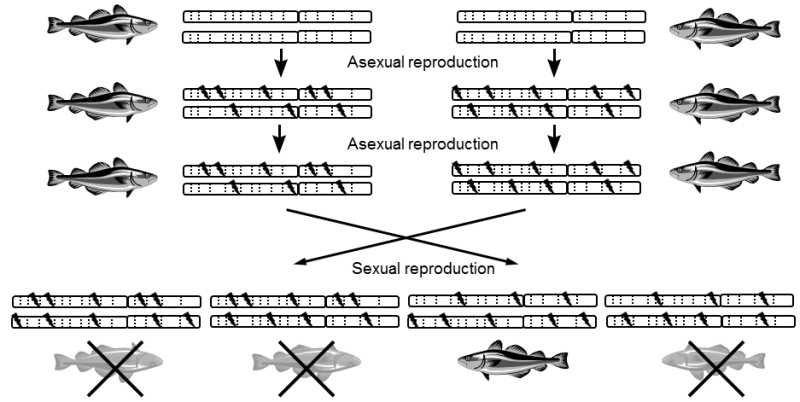XIII.3.1.3 Sexual reproduction maintains the diploid status of the genome
Sexual reproduction is apparently the only known mechanism that permits preservation of the generally advantageous diploid status of the genome (Fig. XIII.4).There would be two copies of each gene in a diploid organismthat reproduced only asexually.If a loss mutation were to occur in one of them, the organism would in no way be placed at a disadvantage thereby and its progeny would not be eliminated from the population by natural selection.If a copy were inactivated, for example, through very extensive deletion, the mutant could even be placed at an advantage as it would not have to synthesize so much DNA.Thus, the mutation would gradually convert the originally diploid genome to agenome that would be haploid from a functional standpoint, containing a large number of nonfunctional genes (pseudogenes).

Fig. XIII.4 Preservation of diploidy by sexual reproduction. If a diploid organism reproduces only asexually for a long time, a large number of mutations accumulate in its genome and always inactivate one of the pair of alleles of the individual genes. After a sufficiently long time, the diploid organism is thus changed into an organism that is functionally haploid. The products of some of the affected genes are essential for the life of the individual, so that the relevant mutations have the character of recessive lethal mutations. If the species reproduces sexually, it is exposed to constant selection pressure against the carriers of recessive lethal mutations. Genotypes that contain both inactive alleles are produced in the progeny of individuals carrying a greater number of these mutations and the carriers of these genotypes are not viable. Accumulation of recessive lethal mutations and thus haploidization of the genome do not occur
Sexual reproduction occurring amphimictically, i.e. through renewal of the diploid state by fusion of two haploid gametes derived from two different individuals, constitutes an effective mechanism preventing similar degeneration of the diploid genome (Lewis & Wolpert 1979).If a nonfunctional variant exists in the genome, in addition to the functional variant of a certain gene (function allele), then part of the progeny of heterozygote parents will inherit a combination of two nonfunctional alleles, which is a state that is very frequently lethal.Thus, there is a constant selection pressure on preservation of both functional alleles of all the vital genes, i.e. on preservation of the diploid state of the genome.
Diploidyis an important factor in biological evolution.Its favourable effect on the speed of evolution is important, for example, in the formation of new genes, in maintenance of polymorphism in the population and possibly also in the emergence of multicellularity.
